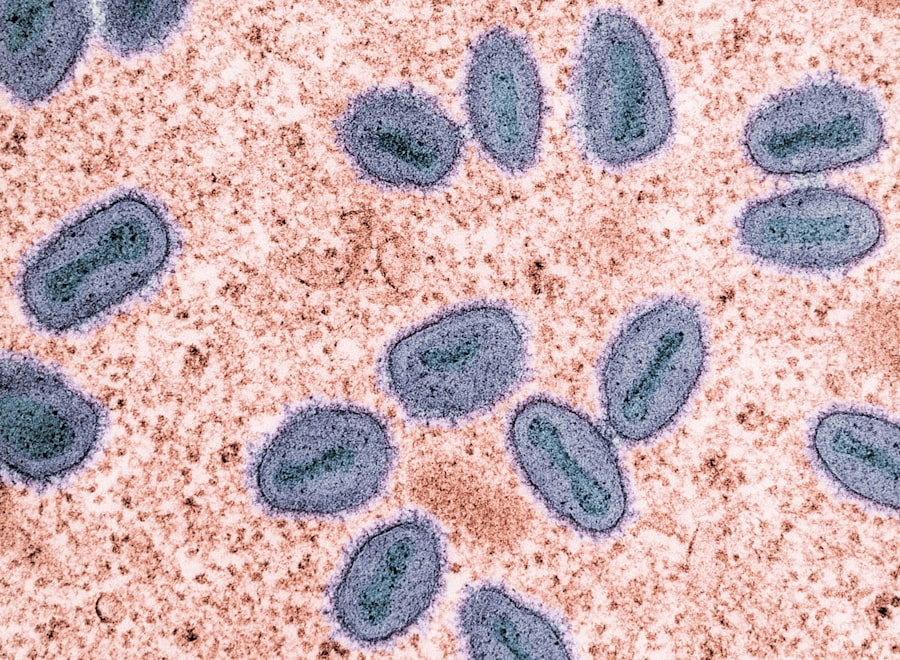The SCN9A gene plays a pivotal role in the way your body perceives pain.
This mutation affects the sodium channels that are essential for transmitting pain signals throughout your nervous system.
Understanding the implications of SCN9A loss of function mutations is crucial, not only for those directly affected but also for the broader medical community seeking to develop effective treatments for pain disorders. As you delve into the complexities of SCN9A mutations, you will discover that they can lead to a condition known as congenital insensitivity to pain (CIP). This rare genetic disorder can profoundly impact your life, as it alters your ability to sense pain, which is a critical protective mechanism.
The exploration of SCN9A mutations opens up a fascinating dialogue about the nature of pain itself and how genetic factors can shape your experiences and responses to injury.
Key Takeaways
- SCN9A loss of function mutation can lead to a rare genetic disorder known as congenital insensitivity to pain (CIP).
- The SCN9A gene plays a crucial role in pain sensation and nociceptive signaling in the body.
- Individuals with SCN9A loss of function mutation may experience symptoms such as insensitivity to pain, inability to feel temperature extremes, and recurrent injuries.
- The impact of SCN9A loss of function mutation on pain perception can result in increased risk of self-injury and delayed wound healing.
- Understanding the implications of SCN9A loss of function mutation on neurological disorders is crucial for developing effective management and treatment strategies.
Understanding the Role of SCN9A Gene in Pain Sensation
The SCN9A gene encodes for a specific type of sodium channel, known as Nav1.7, which is predominantly expressed in sensory neurons. These neurons are responsible for transmitting pain signals from peripheral tissues to the central nervous system. When functioning normally, Nav1.7 channels facilitate the rapid influx of sodium ions, which is essential for generating action potentials that convey pain sensations.
If you consider the intricate dance of electrical signals that occur in your body, the role of SCN9A becomes even more apparent. When a loss of function mutation occurs in the SCN9A gene, the production or functionality of Nav1.7 channels is compromised. This disruption can lead to a diminished ability to transmit pain signals effectively.
As a result, you may find that your perception of pain is significantly altered, leading to either an insensitivity to painful stimuli or an inability to recognize injuries that would typically elicit a pain response. This understanding highlights the importance of SCN9A in maintaining the delicate balance between experiencing pain and protecting yourself from harm.
Symptoms and Manifestations of SCN9A Loss of Function Mutation

Individuals with SCN9A loss of function mutations often exhibit a range of symptoms that can vary widely in severity. One of the most striking manifestations is congenital insensitivity to pain, where you may not feel pain from injuries or medical conditions that would typically cause discomfort. This lack of pain sensation can lead to serious consequences, such as unnoticed fractures or burns, which can result in severe complications if left untreated.
In addition to insensitivity to pain, you may also experience other symptoms related to the mutation. These can include an increased tolerance for extreme temperatures, as well as potential issues with autonomic functions such as sweating and temperature regulation. The absence of pain can create a paradoxical situation where you might engage in risky behaviors without realizing the potential consequences, underscoring the critical role that pain plays in your overall health and safety.
Impact of SCN9A Loss of Function Mutation on Pain Perception
| Metrics | Findings |
|---|---|
| Study Population | Individuals with SCN9A loss of function mutation |
| Pain Perception | Reduced pain perception compared to control group |
| Response to Analgesics | Diminished response to analgesic medications |
| Neurological Symptoms | Reported lower incidence of chronic pain and neuropathic symptoms |
The impact of SCN9A loss of function mutations on your pain perception is profound and multifaceted. While some individuals may experience a complete lack of pain sensation, others might have a reduced ability to perceive certain types of pain, such as sharp or acute sensations. This variability can lead to confusion and challenges in diagnosis, as healthcare providers may not immediately recognize the underlying genetic cause of your symptoms.
Moreover, the altered pain perception associated with SCN9A mutations can affect your emotional and psychological well-being. Living without the ability to feel pain can lead to a false sense of security, where you might underestimate risks or fail to seek medical attention for injuries. This disconnect between physical experiences and emotional responses can create unique challenges in navigating daily life and maintaining overall health.
Effects of SCN9A Loss of Function Mutation on Nociceptive Signaling
Nociceptive signaling is the process by which your body detects and responds to harmful stimuli. The SCN9A gene plays a crucial role in this signaling pathway by encoding sodium channels that facilitate the transmission of nociceptive signals from peripheral tissues to the central nervous system. When a loss of function mutation occurs, this signaling pathway is disrupted, leading to significant changes in how you perceive and respond to potential threats.
As a result, you may find that your body does not react appropriately to harmful stimuli. For instance, if you were to accidentally touch a hot surface, you might not experience the immediate withdrawal reflex that typically protects you from burns. This altered nociceptive signaling can have far-reaching implications for your health and safety, as it may prevent you from recognizing injuries or conditions that require prompt medical attention.
Implications of SCN9A Loss of Function Mutation on Neurological Disorders

The implications of SCN9A loss of function mutations extend beyond pain perception and nociceptive signaling; they also intersect with various neurological disorders. Research has shown that individuals with these mutations may be at an increased risk for developing certain conditions, such as neuropathies or other sensory processing disorders. Understanding these connections is essential for developing comprehensive treatment plans that address not only pain management but also potential neurological complications.
Furthermore, the study of SCN9A mutations offers valuable insights into the broader field of neurology. By examining how these genetic alterations affect neuronal function and signaling pathways, researchers can gain a deeper understanding of other neurological disorders that involve dysregulation of pain perception or sensory processing. This knowledge could pave the way for innovative therapeutic approaches that target specific pathways involved in these conditions.
Management and Treatment of SCN9A Loss of Function Mutation
Managing SCN9A loss of function mutations requires a multidisciplinary approach tailored to your unique needs and symptoms. Since individuals with these mutations often experience insensitivity to pain, it is crucial for healthcare providers to educate you about potential risks and preventive measures. Regular check-ups and monitoring for injuries or infections become essential components of your care plan.
While there is currently no cure for SCN9A loss of function mutations, various strategies can help manage symptoms and improve your quality of life. For instance, physical therapy may be beneficial in promoting mobility and strength while minimizing the risk of injury. Additionally, psychological support can help you navigate the emotional challenges associated with living without pain sensation, fostering resilience and coping strategies.
Current Research and Advances in Understanding SCN9A Loss of Function Mutation
The field of genetics is rapidly evolving, and ongoing research into SCN9A loss of function mutations continues to shed light on their complexities and implications. Scientists are exploring various aspects of this gene, including its role in pain modulation and its interactions with other genetic factors that influence sensory processing. Advances in genomic technologies are enabling researchers to identify new mutations and better understand their functional consequences.
Moreover, studies are investigating potential therapeutic interventions aimed at restoring normal sodium channel function or compensating for the loss of Nav1.7 activity. These innovative approaches hold promise for developing targeted treatments that could enhance pain perception or mitigate risks associated with insensitivity to pain. As research progresses, you may find hope in emerging therapies that could transform the landscape of care for individuals affected by SCN9A mutations.
Genetic Counseling and Testing for SCN9A Loss of Function Mutation
Genetic counseling plays a vital role in understanding SCN9A loss of function mutations and their implications for you and your family. If you suspect that you or a family member may be affected by this condition, seeking genetic counseling can provide valuable insights into inheritance patterns, potential risks for future generations, and available testing options. Genetic testing for SCN9A mutations can confirm a diagnosis and guide management strategies tailored to your specific needs.
By understanding your genetic makeup, you can make informed decisions about your health and well-being while also gaining clarity on any potential implications for family members who may be at risk.
Support and Resources for Individuals and Families affected by SCN9A Loss of Function Mutation
Living with an SCN9A loss of function mutation can present unique challenges, both physically and emotionally. Fortunately, numerous support resources are available to help you navigate this journey. Support groups, both online and in-person, provide opportunities for connection with others who share similar experiences.
These communities can offer invaluable emotional support, practical advice, and shared coping strategies. Additionally, educational resources are available through organizations dedicated to genetic disorders and rare diseases. These resources can help you stay informed about the latest research developments, treatment options, and advocacy efforts aimed at improving care for individuals affected by SCN9A mutations.
Conclusion and Future Directions in Studying SCN9A Loss of Function Mutation
In conclusion, understanding SCN9A loss of function mutations is essential for unraveling the complexities surrounding pain perception and nociceptive signaling. As research continues to advance our knowledge in this area, there is hope for developing targeted therapies that could improve outcomes for individuals affected by these mutations. The interplay between genetics and neurological function remains a rich field for exploration, offering exciting possibilities for future discoveries.
As you reflect on the implications of SCN9A loss of function mutations, consider how ongoing research may shape our understanding of pain mechanisms and lead to innovative treatments that enhance quality of life for those affected by this condition. The journey toward better management strategies and supportive resources is ongoing, underscoring the importance of collaboration among researchers, healthcare providers, and individuals living with these genetic alterations.
Recent studies have highlighted the implications of SCN9A loss of function mutations in pain perception and related disorders. For a deeper understanding of this topic, you can explore the article on Freaky Science that discusses the genetic underpinnings of pain sensitivity and the role of SCN9A. Check it out here: Freaky Science.
WATCH THIS! Why Painlessness Threatens Your Survival
FAQs
What is SCN9A loss of function mutation?
SCN9A loss of function mutation is a genetic mutation that affects the SCN9A gene, which provides instructions for making a protein called Nav1.7. This protein is involved in the transmission of pain signals in the nervous system.
What are the symptoms of SCN9A loss of function mutation?
Individuals with SCN9A loss of function mutation may experience a reduced ability to feel pain, known as congenital insensitivity to pain. They may also have difficulty regulating body temperature and may be prone to injuries due to their inability to perceive pain.
How is SCN9A loss of function mutation diagnosed?
Diagnosis of SCN9A loss of function mutation is typically done through genetic testing. A blood sample or saliva sample is collected and analyzed to identify mutations in the SCN9A gene.
Is there a treatment for SCN9A loss of function mutation?
Currently, there is no specific treatment for SCN9A loss of function mutation. Management of symptoms typically involves addressing the complications associated with congenital insensitivity to pain, such as preventing injuries and monitoring body temperature.
What are the implications of SCN9A loss of function mutation?
SCN9A loss of function mutation can have significant implications for affected individuals, as they may be at risk for injuries and other health complications due to their inability to perceive pain. It is important for individuals with this mutation to receive appropriate medical care and support.
